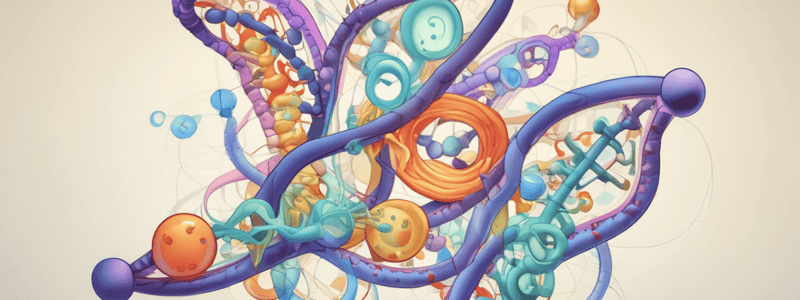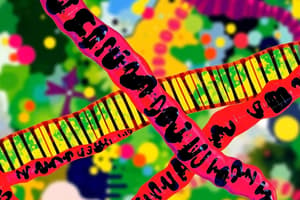Podcast
Questions and Answers
What is the primary function of insulators in gene regulation?
What is the primary function of insulators in gene regulation?
- To silence gene expression
- To promote transcriptional elongation
- To enhance gene expression
- To regulate enhancers and silencers (correct)
Which type of transcription factor has a C2-C2 structure?
Which type of transcription factor has a C2-C2 structure?
- Zinc fingers
- Homeodomain proteins
- Nuclear receptors (correct)
- Helix-turn-helix
What is the role of the recognition helix in helix-turn-helix transcription factors?
What is the role of the recognition helix in helix-turn-helix transcription factors?
- To recruit RNA polymerase II
- To bind to the major groove of DNA (correct)
- To interact with coactivator proteins
- To bind to the minor groove of DNA
Which transcription factor has a combination of a homeodomain and a helix-turn-helix domain?
Which transcription factor has a combination of a homeodomain and a helix-turn-helix domain?
What is the function of leucine zippers in transcription factors?
What is the function of leucine zippers in transcription factors?
How do some transcription factors repress gene expression?
How do some transcription factors repress gene expression?
What is the function of histone acetyltransferases in transcriptional activation?
What is the function of histone acetyltransferases in transcriptional activation?
Which type of transcription factor has a domain that resembles a helix-loop-helix structure?
Which type of transcription factor has a domain that resembles a helix-loop-helix structure?
What is the role of the thyroid hormone receptor co-repressor in transcriptional regulation?
What is the role of the thyroid hormone receptor co-repressor in transcriptional regulation?
Which transcription factor is involved in embryonic patterning?
Which transcription factor is involved in embryonic patterning?
What is the primary function of CAAT box and GC box in regulating gene expression?
What is the primary function of CAAT box and GC box in regulating gene expression?
Which of the following transcription factors is NOT involved in tightly controlled gene expression?
Which of the following transcription factors is NOT involved in tightly controlled gene expression?
What is the role of the C-terminal recognition helix in helix-turn-helix transcription factors?
What is the role of the C-terminal recognition helix in helix-turn-helix transcription factors?
Which of the following mechanisms is involved in transcriptional activation?
Which of the following mechanisms is involved in transcriptional activation?
What is the primary function of zinc fingers in transcription factors?
What is the primary function of zinc fingers in transcription factors?
Which type of transcription factor has a domain that resembles a helix-turn-helix structure?
Which type of transcription factor has a domain that resembles a helix-turn-helix structure?
What is the role of Myc in transcriptional regulation?
What is the role of Myc in transcriptional regulation?
Which of the following is a characteristic of leucine zipper transcription factors?
Which of the following is a characteristic of leucine zipper transcription factors?
What is the primary function of histone acetyltransferases in gene regulation?
What is the primary function of histone acetyltransferases in gene regulation?
Which of the following is an example of a transcription factor that affects chromatin structure?
Which of the following is an example of a transcription factor that affects chromatin structure?
What is the primary function of enhancers in gene regulation?
What is the primary function of enhancers in gene regulation?
Which of the following transcription factors has a domain that resembles a zinc finger?
Which of the following transcription factors has a domain that resembles a zinc finger?
What is the primary function of silencers in gene regulation?
What is the primary function of silencers in gene regulation?
Which of the following is NOT a characteristic of helix-turn-helix transcription factors?
Which of the following is NOT a characteristic of helix-turn-helix transcription factors?
What is the primary function of promoters in gene regulation?
What is the primary function of promoters in gene regulation?
Which of the following is a characteristic of leucine zipper transcription factors?
Which of the following is a characteristic of leucine zipper transcription factors?
What is the primary function of histone deacetylases in gene regulation?
What is the primary function of histone deacetylases in gene regulation?
Which of the following transcription factors is involved in tightly controlled gene expression?
Which of the following transcription factors is involved in tightly controlled gene expression?
What is the primary function of insulators in gene regulation?
What is the primary function of insulators in gene regulation?
Which of the following is a characteristic of helix-loop-helix transcription factors?
Which of the following is a characteristic of helix-loop-helix transcription factors?
Flashcards
Insulator Function
Insulator Function
Insulators act as barriers that prevent enhancers from activating promoters located on the other side of the insulator.
Nuclear Receptors
Nuclear Receptors
Nuclear receptors bind to specific DNA sequences and regulate gene expression in response to hormone binding.
Recognition Helix
Recognition Helix
The recognition helix interacts with the major groove of DNA, allowing for specific recognition of DNA sequences.
POU Transcription Factors
POU Transcription Factors
Signup and view all the flashcards
Leucine Zippers
Leucine Zippers
Signup and view all the flashcards
Repressor Function
Repressor Function
Signup and view all the flashcards
Histone Acetyltransferases
Histone Acetyltransferases
Signup and view all the flashcards
Basic Helix-Loop-Helix (bHLH) Transcription Factors
Basic Helix-Loop-Helix (bHLH) Transcription Factors
Signup and view all the flashcards
Thyroid Hormone Receptor Co-Repressor
Thyroid Hormone Receptor Co-Repressor
Signup and view all the flashcards
HOX Genes
HOX Genes
Signup and view all the flashcards
CAAT Box and GC Box
CAAT Box and GC Box
Signup and view all the flashcards
Housekeeping Genes
Housekeeping Genes
Signup and view all the flashcards
C-Terminal Recognition Helix
C-Terminal Recognition Helix
Signup and view all the flashcards
Acetylation of Histones
Acetylation of Histones
Signup and view all the flashcards
Zinc Fingers
Zinc Fingers
Signup and view all the flashcards
POU Proteins
POU Proteins
Signup and view all the flashcards
Myc Transcription Factor
Myc Transcription Factor
Signup and view all the flashcards
Leucine Zipper Structure
Leucine Zipper Structure
Signup and view all the flashcards
Histone Acetyltransferase Function
Histone Acetyltransferase Function
Signup and view all the flashcards
FoxA Transcription Factor
FoxA Transcription Factor
Signup and view all the flashcards
Enhancer Function
Enhancer Function
Signup and view all the flashcards
Nuclear Receptors
Nuclear Receptors
Signup and view all the flashcards
Silencer Function
Silencer Function
Signup and view all the flashcards
Helix-Loop-Helix Structure
Helix-Loop-Helix Structure
Signup and view all the flashcards
Promoter Function
Promoter Function
Signup and view all the flashcards
Leucine Zipper Dimerization
Leucine Zipper Dimerization
Signup and view all the flashcards
Histone Deacetylase Function
Histone Deacetylase Function
Signup and view all the flashcards
Homeodomain transcription factors
Homeodomain transcription factors
Signup and view all the flashcards
Insulator Function
Insulator Function
Signup and view all the flashcards
Helix-Loop-Helix Dimerization
Helix-Loop-Helix Dimerization
Signup and view all the flashcards



